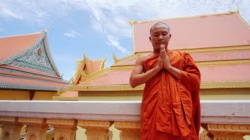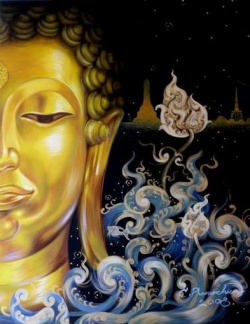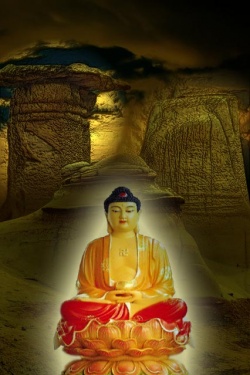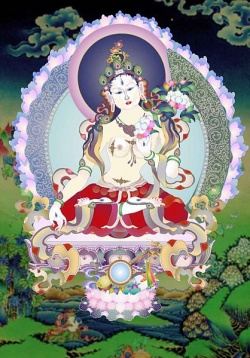White in Buddhist Color Symbolism
White is a tone, the perception which is evoked by light that stimulates all three types of color sensitive cone cells in the human eye in near equal amount and with high brightness compared to the surroundings.
Since the impression of white is obtained by three summations of light intensity across the visible spectrum, the number of combinations of light wavelengths that produce the sensation of white is practically infinite.
There are a number of different white light sources such as the midday Sun, incandescent lamps, fluorescent lamps and white LEDs. The impression of white light can also be created by mixing appropriate intensities of the primary colors of light - red, green and blue (RGB) - a process called additive mixing, as seen in many display technologies.
White light reflected off objects can be seen when no part of the light spectrum is reflected significantly more than others and the reflecting material has a degree of diffusion. This is seen when transparent fibers, particles, or droplets are in a transparent matrix of a substantially different refractive index. Examples include classic "white" substances such as sugar, foam, pure sand or snow, cotton, clouds, and milk.
Crystal boundaries and imperfections can also make otherwise transparent materials white, as in the milky quartz or the microcrystalline structure of a seashell. This is also true for artificial paints and pigments, where white results when finely divided transparent material of a high refractive index is suspended in a contrasting binder. Typically paints contain calcium carbonate and/or synthetic rutile with no other pigments if a white color is desired.
Paint
In painting, white can be crafted by reflecting ambient light from a white pigment, although the ambient light must be white light, or else the white pigment will appear the color of the light. White when mixed with black produces gray. To art students, the use of white can present particular problems, and there is at least one training course specializing in the use of white in art. In watercolor painting, white areas are the absence of paint on the paper. When mixing paints in order to get a lighter color, it's advisable to mix a small amount of color to white, rather than trying to add white to the color, as it will take considerably more paint to get the desired tint.
White and Clear Quartz Crystals
White light is the octave (frequency) above purple. It has always been seen as transcendence, pure, perfection, innocence, chastity, the triumphant of spirit over the flesh, purity.
In Alchemy white is the feminine principle or highest frequency of though turning into pure consciousness.
Wearing white links to the goddess in many civilizations.
Druid priests often wore white.
In Christian beliefs white is the highest color representing the purified soul, joy, virginity, integrity, light and a holy life. White is always worn in Christian religions at the sacraments of Baptism, First Communion, Confirmation, Marriage. In Catholicism it is symbolic of the saints not suffering martyrdom and virgin saints.
To the Buddhist tradition, white is self-mastery and redemption. It is representative of being lead from bondage - the highest spiritual transformation.
In Hinduism, white is symbolic of pure consciousness, upward movement, light, and manifestation.
Maori tradition holds white as meaning truce or surrendering.
In Mayan tradition it represented peace and health.
White is not really a color. It occurs when the whole spectrum of light is seen together or when red, yellow and blue colors are mixed.
Everything is present in white; nothing is hidden, secret or undifferentiated.
Thus Saraswati, the goddess of learning and knowledge, is shown white in color. Indeed knowledge and learning should not be hidden, but be open and available to all.
White color is thought to have a very cold quality, as in snow, or an extremely hot quality, such as a burning metal.
Either one can be life threatening and reminds us of death and the end of things. Fittingly, therefore, the goddess Tara in her form which grants longevity to worshippers is depicted as white hued (White Tara).
She also denotes purity, holiness and cleanliness and is 'the one who leads out beyond the darkness of bondage'.
White is a color that both incorporates, and set things apart from the rainbow spectrum of everyday life.
The color white appears in numerous Buddhist episodes, one of the most well known being the birth of Buddha. Legend states that Queen Maya, mother of Buddha dreamt of a white elephant that flew through the air and touched her right side with its trunk. Now elephants are well known for their strength and intelligence, and are also associated with gray rain clouds and fertility. Indeed rainwater means that the seeds will be able to germinate and vegetative life will be able to spring forth.
The white color of the majestic animal adds to this narrative an element of purity and immaculacy. In his former lives the Buddha had been an elephant several times, as mentioned in the Jatakas, or tales of his previous births. The white elephant is believed to have been the future Buddha himself who descended from heaven so that he could be born. It thus also represents for queen Maya a chaste birth, or the element of the triumph of spirit over the flesh.



